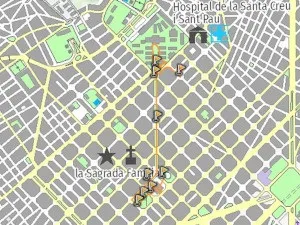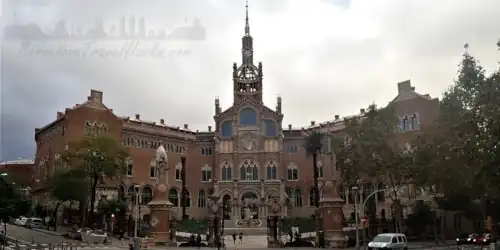
Sagrada Família Barcelona – Tickets, Tips & Gaudí’s Legacy
Explore Gaudí’s iconic Sagrada Família in Barcelona. Get tickets, visiting tips, opening hours, and history of this UNESCO-listed modernist basilica
About La Sagrada Família
The most famous and visited tourist attraction in Spain (with over 1.7 million visitors in 2019) resides in Barcelona. I am of course talking about La Sagrada Família, the 20th-century Antoni Gaudí basilica that has been under construction since 1882. This UNESCO-listed masterpiece blends Gothic and modernist architecture and continues to evolve as one of the most iconic landmarks in Europe.
Why is it taking so long to construct La Sagrada Família?
Like many historic cathedrals, La Sagrada Família has faced decades of delays due to war, economic challenges, and the death of its visionary architect. Construction was interrupted by the Spanish Civil War, the loss of Gaudí’s original plans, and more recently, the global COVID-19 pandemic. Below is a timeline of key construction milestones and historical events that shaped the basilica’s journey.
- 1882 Architect Francisco de Paula del Villar begins work with a neo-Gothic design but leaves the project.
- 1883 Antoni Gaudí takes over and inaugurates the chapel of Sant Josep in 1885.
- 1891 Work begins on the Nativity Façade; Gaudí dedicates himself exclusively to the temple from 1914.
- 1925 Saint Bernabé tower completed; Gaudí dies in 1926 after being struck by a tram. Domènec Sugrañes i Gras takes over.
- 1936 Civil War destroys Gaudí’s plans and models in a fire.
- 1939 Francisco de Paula Quintana resumes work using surviving photos and published plans.
- 1952 Nativity Façade completed and illuminated; Passion Façade foundations laid in 1954.
- 1958 Sculptures of the sacred family by Jaume Busquets i Mollera added to the Nativity Façade.
- 1966 Quintana dies; Isidre Puig i Boada and Lluís Bonet i Gari take over.
- 1976 Passion Façade bell towers completed; side aisle façades begin in 1978.
- 1976 Francesc Cardoner i Blanch becomes director of works.
- 1985 Jordi Bonet i Armengol succeeds Cardoner; Josep Maria Subirachs i Sitjar sculpts the Passion Façade.
- 1986 Construction begins on the main nave, transepts, and apse; completed in 2010.
- 2005 Nativity Façade and Crypt declared UNESCO World Heritage Sites.
- 2010 Pope Benedict XVI consecrates the basilica as a Minor Basilica.
- 2012 Jordi Faulí i Oller becomes lead architect and remains in post.
- 2016 Construction begins on the Evangelist, Mary, and Jesus towers; they surpass the height of earlier façades by 2020.
- 2020 Construction paused due to COVID-19; resumes in October with focus on the Virgin Mary tower.
- 2021 Virgin Mary tower completed at 138 meters, topped with an illuminated Morning Star. Gaudí insisted the basilica not exceed the height of Tibidabo.
- 2022 Luke and Mark Evangelist towers completed and illuminated.
- 2023 Glory Façade construction begins on Carrer de Mallorca; skeletal columns completed.
- 2026 Planned completion of the central Jesus Christ tower to mark the centenary of Gaudí’s death. Decorative finishes expected by 2028–2030.
Image Gallery For La Sagrada Família
Click on any of the 78 images to open full screen gallery player. Note that viewing images is subject to our Fair Use Policy.
Visiting La Sagrada Família
When you visit, you'll immediately notice the darker stonework — a visual marker of Gaudí’s original construction. During his era, the basilica had no roof and lacked connecting walls between the Nativity and Passion façades.
Controversy Surrounding Modern Materials
Gaudí’s original vision relied on traditional techniques using carved stone. Today, construction incorporates steel-reinforced concrete with stone cladding — a modern approach that has sparked debate among purists.
Since many of Gaudí’s plans were destroyed during the Spanish Civil War, questions remain about how closely the current design reflects his intent. The use of CAD software and CNC milling machines has accelerated progress, replacing hand-carved stonework with precision engineering.
Is La Sagrada Família Worth Visiting?
I’ve visited La Sagrada Família multiple times since 2005, and each visit reveals something new. Back then, the interior was open to the sky, filled with scaffolding. Only the exterior façades and tower access were complete — and tickets cost just 8 euros!
Today, the interior is breathtaking. Tree-like columns rise to a spectacular vaulted ceiling, and the stained glass windows by master glazier Joan Vila-Grau bathe the nave in vibrant color. It’s unlike any other cathedral in the world.
This is an unmissable attraction in Barcelona. Whether you admire architecture, history, or spiritual spaces, La Sagrada Família will leave you in awe — from the street view to the intricate interior. If you need more convincing, browse the image gallery above.
Ticket prices are higher now, but every euro supports the ongoing construction, managed by La Junta Constructora. You’re not just visiting — you’re contributing to a living masterpiece.
Sagrada Família Tips
- Entry is via Carrer de Marina. Expect airport-style security. Avoid large bags — only small handbags and rucksacks are allowed.
- Tickets include access to an audio guide app. Download it in advance and bring headphones.
- Book early, especially in summer, to secure your preferred date and time.
- Morning slots offer better lighting for photos and a quieter experience inside.
- There’s no time limit for visits. Allow 1–2 hours to explore fully.
- As a consecrated Major Basilica, modest dress is required. See the packing section for guidelines.
- Arrive 5–10 minutes early. If you have time to spare, enjoy views from Parc Gaudí or Parc de la Sagrada Família.
Sagrada Família Opening Hours
- November to February: 09:00h to 18:00h
- March: 09:00h to 21:00h
- April to September: 09:00h to 20:00h
- October: 09:00h to 19:00h
- December 25th & 26th, January 1st & 6th: 09:00h to 14:00h
Other Gaudí Works
Gaudí’s former residence is located in Parc Güell, though it’s not included in the Sagrada Família ticket. Consider a combo ticket for Parc Güell and the Gaudí House Museum. Details on the Parc Güell page.
In Passeig de Gràcia, visit Casa Milà (La Pedrera) and Casa Batlló.
Near Las Ramblas, explore Palau Güell, a castle-style house by Gaudí.
In the Gràcia neighborhood, visit Casa Vicens. In Sant Gervasi, check out Torre Bellesguard.
Each Gaudí house is visually distinct and offers a unique glimpse into his architectural genius.
What to Do After Visiting Sagrada Família
The area around La Sagrada Família is packed with bars and restaurants. Below are some of my favorites. For a cultural follow-up, walk along Avenida Gaudí to the stunning Recinte Modernista de Sant Pau.
What to take with you for La Sagrada Família
Large rucksacks, suitcases, and oversized bags are not permitted inside La Sagrada Família, and there are no locker facilities available. Pushchairs are allowed.
Disabled access is available via Carrer de Marina. The basilica provides wheelchairs upon request — call +34 935 132 060 or email informacio@sagradafamilia.org. Wheelchairs are delivered to the entrance for visitors with mobility needs.
The main visit route is on a single level. However, the crypt is only accessible by stairs, and tower visits require climbing narrow staircases and crossing an elevated air bridge — not suitable for wheelchairs or pushchairs.
Don’t forget to bring headphones for the audio guide app, which you can download using the link provided with your online ticket purchase.
Bicycle anchorage points are located outside La Sagrada Família at Carrer de Mallorca and Carrer de Marina, near the metro station exit.
La Sagrada Família Dress Code for Visitors
- Dress Code for Men:
- T-shirts and shirts without offensive or promotional designs
- Full-length trousers or jeans; knee-length shorts are acceptable
- Sleeveless tops, vests, and hats are not allowed
- No swimwear
- Dress Code for Women:
- Tops with sleeves that fully cover the shoulders
- No backless dresses or deep necklines
- Trousers or skirts must extend below mid-thigh
- No hats or swimwear
- Dress Code for Children:
- Same rules as adults apply
- Tops must cover the shoulders
- Trousers or skirts must extend below the thighs
- No swimwear or hats
Tickets for La Sagrada Família
Getting to La Sagrada Família
Address: Carrer de la Marina 253, Barcelona, 08013
Nearest TMB metro station is Sagrada Família, served by the Blue (L5) and Purple (L2) lines. For convenient travel, use a T-Casual ticket or the Hola Barcelona Travel Card.
You can also reach Sagrada Família via the Hop-On Hop-Off Barcelona Tourist Bus on the Blue Route.
Documents for La Sagrada Família
Wikiloc Trail for La Sagrada Família

Please sign in with Google to view the Wikiloc Route map.
Sign in with GoogleWeather for La Sagrada Família
Where to stay overnight near La Sagrada Família
Nearby Attractions to La Sagrada Família
 METRO
METRO
Recinte Modernista Sant Pau – Art Nouveau Museum in Barcelona
Explore Sant Pau’s stunning art-nouveau hospital complex in Barcelona. A UNESCO World Heritage museum designed by Lluís Domènech i Montaner
Read more >
 METRO
METRO